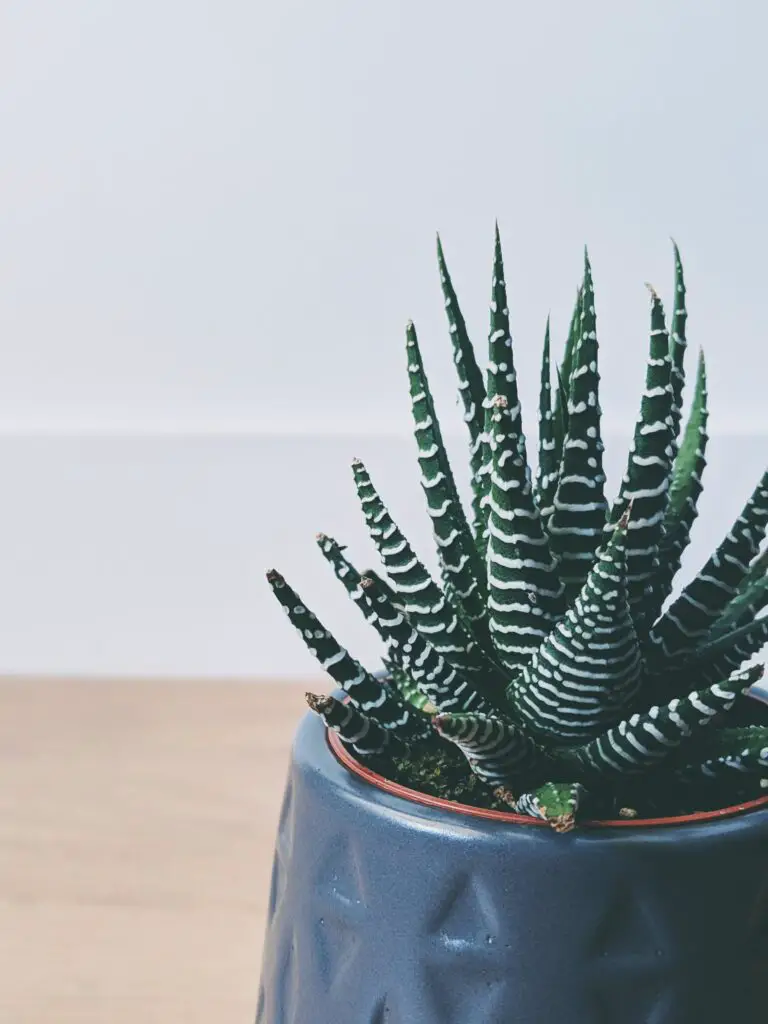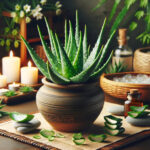Introduction
Picture this: a plant so stately and striking, its sculptural leaves jutting out in all directions, a hint of the exotic in its very silhouette. No, it’s not from a Hollywood movie set. Welcome to the world of the Aloe Arborescens. Curious yet? Let’s dive in.

If you’re familiar with the realm of flora, you’ve likely heard of aloe vera. Shelves bustling with health, hair, and skin care products singing aloe vera’s praises are a common sight. However, there’s another member of the aloe family that you may be less acquainted with – the Aloe Arborescens. It’s not just about beauty and health; it’s about botanical wonder too.
Indeed, Aloe Arborescens is not your average backyard plant. It’s a botanical marvel that, quite literally, thrives beyond beauty and health. Growing from an imposing central trunk, it shoots out multiple branches, each lined with sharp, succulent leaves. Seeing it in person, you might even draw comparisons to a grand candelabra!
But that’s not all. Though typically thought of as desert plant, it’s impressive how well Aloe Arborescens can adapt to various climate conditions. This trait has allowed it to spread across different regions, including Malawi, Zimbabwe, Mozambique, and South Africa.
Want to delve deeper into this wonderful plant? Check out this guide to growing Aloe Arborescens.
Botanical Characteristics
It’s fair to say that Aloe Arborescens is a plant of stature and grandeur. Just take its size for example. This plant can stretch up to 2-3m high and spread across a similar width. It’s enough to make it the centerpiece of any garden!
When in full bloom, Aloe Arborescens is a sight to behold. Its inflorescences – that’s the complete flower head of a plant, including stems, stalks, and flowers – are brightly colored and densely packed. Adorned with cylindrical, tubular flowers, each inflorescence looks like a fiery torch against the rest of the greenery.
All in all, Aloe Arborescens is an extraordinary plant that combines architectural beauty with botanical interest. Whether it’s thriving in your garden or enhancing your well-being, this plant offers more than meets the eye.
Aloe Arborescens vs Aloe Vera: A Showdown of Aloe Plants
When it comes to the world of succulents, aloe plants have rightly claimed a spot at the top. Among the most renowned are Aloe Arborescens and Aloe Vera. Both boast incredible health benefits and distinct characteristics, resulting in a close-knit competition. But how exactly do they differ, and what similarities do they share? Let us dive headfirst into this botanical showdown.
Aloe Vera has long been lauded for its medicinal uses, providing a range of benefits from skin soothings to digestion aid. It’s a plant that’s synonymous with healing and care, and with good reason. The cooling, transparent gel inside Aloe Vera leaves is a popular treatment for burns, dry skin, and even scars.
On the other side, we have Aloe Arborescens. This plant may not enjoy the same level of fame as its counterpart, but it packs a significant punch in terms of health benefits and resilience. With its narrower leaves and woody stem, it’s an incredibly hardy specimen, thriving even in less favourable conditions. The gel content may be lower than that of Aloe Vera, but this doesn’t make it any less useful. It has been reported to have a high concentration of anthraquinone elements, responsible for its potential antiviral, antimicrobial and antitumor properties.

When comparing these two aloe species, it’s worth noting their distinct appearances. Aloe Vera typically has thicker, fleshier leaves packed with the beneficial gel we admire. In contrast, Aloe Arborescens often dons a more intricate look with its slim, torch-like flowers rising high above the leaves, earning it the moniker “candelabra aloe”.
The nutrition content also exhibits significant differences between the two. Aloe Vera, while boasting nearly 75 potentially active components including vitamins, enzymes, minerals, and more, tends to fall short when compared to the nutritional wealth Aloe Arborescens offers. Packed with a higher content of amino acids and other vital nutrients, Aloe Arborescens stands a strong contender in this comparison.
To get a hands-on understanding about the difference between Aloe Vera and Aloe Arborescens, you can explore more on aloefatherzago.com.
Ultimately, although they share the same family and similar benefits, the application and effectiveness of Aloe Vera and Aloe Arborescens can vary greatly, offering a variety of uses in the realm of health and beauty. No matter which you choose, these aloe plants hold great potential to improve wellbeing and enhance everyday life.
The Impressive Health Benefits of Aloe Arborescens
When it comes to nature’s pharmacy, Aloe Arborescens holds a prime spot. Hailing from the vibrant continents of Africa, this succulent has more to offer than just visual allure, and it’s generously endowing the wellness realm with its impressive range of health benefits.

Getting into the core, Aloe Arborescens leaves are filled with a cocktail of beneficial compounds. So what makes this green gem a superstar in the health department?
Anti-Cancer Properties
‘Anti-cancer’ might sound like a heavy term, but this is precisely one area where Aloe Arborescens shines. Medical research has highlighted its potential in retarding the growth of cancer cells. Imagine, adding a pinch of Aloe Arborescens extract into your daily food could be an easy step to fortify your body’s defense against this severe disease. Not so scary now, right?
Detoxifying Effects
You’ve likely heard about ‘detoxification,’ but how about doing it in a natural, non-convoluted way? That’s where Aloe Arborescens steps in. It boosts the removal of toxins from the body and stimulates liver function, reflecting in clean, glowing skin and a refreshing feeling from within. So, instead of opting for an overpriced detox diet, why not turn towards this plant of immortality?
Digestion Support
Remember those pesky digestion issues that withhold you from savouring your favourite cuisine? Aloe Arborescens might be the answer. The plant is known to soothe the digestive system, mitigating issues like heartburn and irritable bowel syndrome. So go ahead, live your culinary dreams with a natural digestion supporter on your side.
Comprehensively, the health benefits of Aloe Arborescens touch upon several aspects of human wellness. And what’s even more exciting is that this is merely the tip of the iceberg, and its full potential is yet to be unleashed. So, next time when you look at this plant, remember, you are gazing at not just a piece of botanical beauty but a splendid powerhouse of health benefits.
Nutritional Riches Hidden in Aloe Arborescens
If you’ve ever wondered why Aloe Arborescens is often dubbed as a ‘wonder plant,’ you’re about to uncover some gratifying facts. This section will take you on an exciting exploration of its nutritional components, focusing particularly on its vitamins, minerals, amino acids, and phytonutrients.
Aloe Arborescens, often overshadowed by its sibling Aloe Vera, is a treasure trove of nutrients. Picture yourself biting into a juicy apple. The burst of vitamins and minerals you get from it is quite akin to what you would get from Aloe Arborescens. The difference is that Aloe Arborescens plays a unique health and beauty game.
The mineral composition of Aloe Arborescens reads like a health utopia. Calcium, magnesium, potassium, copper, iron, zinc, and manganese are all essential minerals for various bodily functions. They are all found in this resilient cactus-like plant. Doesn’t this remind you of your favorite multivitamin?
But that’s not all. This plant also contains 20 of the 22 essential amino acids required by the human body for protein synthesis and tissue repair. Picture it like a gym supplement that is working tirelessly to repair your muscle tissue after an intense workout. Isn’t it impressive?
Remember the joy of being told that your favorite chocolate bar is packed with antioxidants? The same joy should overwhelm you when you know that Aloe Arborescens possesses power-packed antioxidants in the form of phytonutrients. They’re the vigilantes of your body, protecting it from oxidative stress. That’s more power to this beautiful succulent!
Let’s not forget the vitamin fiesta that Aloe Arborescens brings to the table. It comes loaded with vitamins A, C, E, B1, B2, B3, and B6. Consider it a diverse buffet-like spread for your body.
Your body thanks you for every sip of Aloe Arborescens juice, every dollop of skin cream made from it, and even the aroma of a soothing Aloe Arborescens health candle. This plant, a beauty in its own right, arms you with health and vitality.
Growing and Caring for Aloe Arborescens
Imagine a plant that’s as tough as it is visually pleasing. That’s the Aloe Arborescens for you. Unlike its popular cousin Aloe Vera, Aloe Arborescens is less vulnerable to disease, thrives in varied climates, and is lovely to look at.
But how do you raise these stouthearted beauties? Here’s your step-by-step guide to raising your own Aloe Arborescens.
Knowing Your Plant
Before getting your hands dirty, it’s essential to understand what makes Aloe Arborescens unique. This plant, native to South Africa, is hardier and easier to manage than its notorious relative, Aloe Vera. Its succulent leaves and vibrant blooms make it both a landscaping favorite and a health-boosting supplement.
Although tough, Aloe Arborescens do have some basic needs to meet if they are to thrive. Understanding these needs is the first step to successful Aloe Arborescens gardening.
Choosing the Right Spot
A crucial step in Aloe Arborescens care is selecting the correct location. These plants enjoy a generous amount of sunlight and can tolerate a range of temperature fluctuations. However, be mindful of extreme temperatures. While mature plants can endure colder weather, freezing conditions might cause the plant to wilt or even die.
Favorable Soil Conditions
When it comes to soil, Aloe Arborescens prefers well-draining soil. These plants don’t need particularly fertile soil as their root system is quite efficient at extracting nutrients. Still, you might want to consider mixing some compost into the soil to enrich it and ensure your Aloe Arborescens grows robust and healthy.
Watering Needs
Like all succulents, Aloe Arborescens can cope with periods of dryness. Overwatering is a big no-no as this can lead to root rot. A good watering rule is to soak the soil thoroughly but make sure it dries out completely before watering again.
Final Tips
While Aloe Arborescens are somewhat forgiving, they still appreciate a little TLC. Make sure they have enough light and just the right amount of water, and these robust plants will reward you with their striking beauty and health benefits.
To give you a more practical guide, here’s a video showing the basic care for Aloe.
Home and Garden Applications of Aloe Arborescens
Often perceived as just a healer, Aloe Arborescens is a versatile plant that extends its benefits beyond health to aesthetics and utility in our homes and gardens.
As a Decorative Element
First, consider the visual appeal of Aloe Arborescens. The plant’s verdant, spiky look offers a bold visual statement effective in modern and minimalist designs, bringing a touch of unexpected natural elegance. When planted in clusters or as single centerpieces, they induce a certain allure and fascination, enhancing the aesthetic value of your space.
Natural Repellent
Moving beyond its beauty, did you know that Aloe Arborescens can act as a natural repellent? We all love to enjoy a beautiful garden or a balcony free from unwanted pests. Here lies the usefulness of Aloe Arborescens. The plant’s bitter leaves deter many garden pests, preserving the tranquility of your outdoor haven. Now that’s what we call eco-friendly pest control!
To add to your knowledge on how to effectively decorate and maintain your garden with Aloe Arborescens, here’s a helpful video on the subject:
As we can see, Aloe Arborescens is not just a healer but a home and garden hero. So let’s embrace the power of this incredible plant, and create thriving and functional spaces brimming with beauty and practicality.
Culinary Uses of Aloe Arborescens
When you look at Aloe Arborescens, the first thing most people see is a plant of unparalleled beauty. But look closer, and you’ll discover so much more. Apart from its well-documented health benefits, Aloe Arborescens is a hidden gem in the culinary world. Yes, you read that right, this striking plant doubles as an ingredient in both traditional recipes and modern foods and beverages!
Think of aloe, and your mind might go to soothing sunburns. However, Aloe Arborescens- a lesser-known but equally powerful species- is edging its way into kitchens around the world. While it’s been used for centuries in traditional fare, food innovators are also finding a place for it in modern cuisine.
For example, let’s talk about Aloe Arborescens-based juices and teas. Its leaves are rich in nutrients and antioxidants that, when juiced or steeped into tea, offer an uplifting and healthful beverage. These drinks are not only refreshing but also bring transformative health benefits like aiding digestion and enhancing skin health.
Salads are another way to introduce this plant to your diet. The gel from Aloe Arborescens leaves can be mixed with other fresh ingredients to create unique and delicious salads. Its slightly bitter taste complements the natural sweetness of fruits like apples and peaches wonderfully.
And then there are desserts! From gelatos to sorbets, Aloe Arborescens is making a sweet entry into this category. Its mild flavor and health benefits make it a super addition to a range of desserts. In Japan, Aloe Arborescens jelly is a popular sweet treat, often served with a dusting of powdered sugar for a burst of sweetness.

While cooking with Aloe arborescens might seem like a modern trend, it’s essential to acknowledge its traditional roots. Many cultures have showcased the versatility of this plant in their cuisines for centuries. In Brazil, for instance, they use Aloe Arborescens in ‘Baba de Quiabo’, a traditional okra dish. In South Africa, they cook ‘Aloe Soup’, a succulent stew made from the plant’s leaves.
As you can see, the culinary uses of Aloe Arborescens are as varied as they are exciting. The next time you come across this stunning plant, remember that beneath its arborescent beauty lies a culinary adventure waiting to be explored!
Conclusion
As we draw to the end of this enlightening exploration into the world of Aloe Arborescens, one can’t help but marvel at this plant’s undeniable resilience and undeniable benefits. This plant intricately intertwines both beauty and health, thereby creating a stunning spectacle of nature’s genius.
From a visually appealing ornamental plant in your garden to a therapeutic ingredient in your medicine and skincare products, Aloe Arborescens thrives beyond its physical appearance. The versatility of this plant is nothing short of fascinating.
Just imagine – with just one plant species, you get beautiful skin, boosted immunity, and a revived digestion, and this list only scrapes the surface of the benefits of Aloe Arborescens. It’s not just a plant; it’s a powerhouse of wellness packed into one.
Check out this video to peek into the incredible world of Aloe Arborescens:
Final Thoughts
In conclusion, Aloe Arborescens is an astounding testament to the multifaceted utility of plant life. It serves as an irreplaceable model showing that plants are more than just the greenery enhancing our environment.
When you next spot an Aloe Arborescens — whether in a garden, a botanical illustration, a skincare product, or a health supplement — remember, it’s not just a plant. It’s an emblem of thriving beyond beauty and health. It’s Aloe Arborescens, and it is here to change the way we perceive plant life.
So, why don’t we harness the power of such plants and promote a healthier, more sustainable future for ourselves? With plants like Aloe Arborescens, we certainly have the potential to.
FAQs about Aloe Arborescens
Welcome to the section where we address the most frequently asked questions about the fascinating Aloe arborescens. We believe that additional knowledge is power, so let’s dive right in and streamline your understanding of this magnificent plant.

What is Aloe arborescens and how does it differ from more common aloe varieties?
Aloe arborescens is a unique species of the aloe family. While it might be likened to the more familiar Aloe vera, it holds its own with several distinguishing features. For one, it’s known as the only other member of this family that holds medicinal properties equal to or even surpassing Aloe vera.
Where can Aloe arborescens be found?
Native to the coastal areas and mountains of southern Africa, Aloe arborescens has been revered and used for centuries, and now it’s cultivated worldwide. It’s not only valued as a medicinal plant, but its vibrant flowers also make it a stunning addition to any garden or indoor setting.
How do I care for Aloe arborescens?
Caring for Aloe arborescens isn’t as tricky as you might think—a fact that contributes to its worldwide popularity. Like most succulents, it requires minimal watering and plenty of sunshine. Too much water can lead to root rot, so it’s better to err on the side of caution when reaching for that watering can.
What are the health benefits of Aloe arborescens?
Similar to Aloe vera, the uses of Aloe arborescens in health and beauty regimens are aplenty. The gel inside the leaves is rich in beneficial compounds with antimicrobial and anti-inflammatory properties—it can be applied directly to the skin to soothe burns, ulcers, and skin diseases. Taken internally, it’s been touted for its potential positive effects on immune health, digestion, and even cardiovascular health.
Always remember, it’s important to consult with a healthcare professional before starting or changing any health routines.
Can Aloe arborescens be harmful?
Although typically safe, Aloe arborescens may cause allergic reactions in some people, so a patch test is always a good idea before widespread use. Additionally, consuming large quantities, especially on an empty stomach, can result in stomach discomfort and other side effects.
Armed with this information, you’re well on your way to becoming an Aloe arborescens aficionado! Delve further into this captivating plant, and you might find yourself smitten with its undeniable allure.



